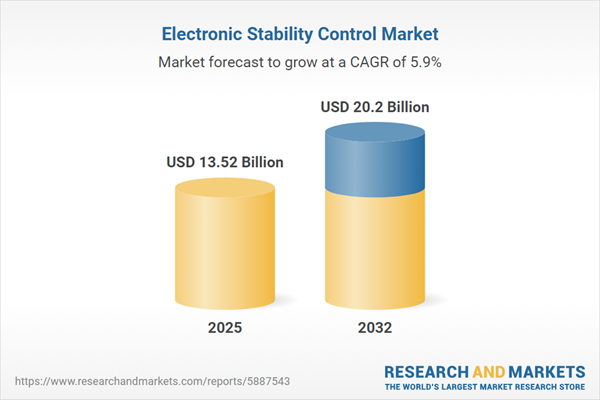Speak directly to the analyst to clarify any post sales queries you may have.
The electronic stability control market continues to transform as industry leaders respond to emerging safety standards, digital innovation, and fast-changing regulatory environments. Senior decision-makers need clear, actionable intelligence to drive procurement planning and maintain competitive advantage in this dynamic landscape.
Market Snapshot: Electronic Stability Control Market Trajectory
In 2024, the electronic stability control market is valued at USD 12.75 billion, with projections to grow to USD 13.52 billion by 2025. This reflects a compound annual growth rate (CAGR) of 5.91%, driven by updated regulatory measures and increasing adoption of advanced automotive safety solutions. Looking ahead, the market is expected to reach USD 20.20 billion by 2032.
Scope & Segmentation of the Electronic Stability Control Market
This report provides executive-level insights into the electronic stability control market, assisting leaders in shaping procurement, compliance, and technology strategies. The analysis covers the following segments and drivers essential for strategic planning:
- Component Type: Reviews the role of control units, digital signal processors, microcontrollers, hydraulic systems, and advanced sensors, all of which enhance system analytics and contribute to progressive safety management.
- Vehicle Type: Assesses applications across electric, commercial, and passenger vehicles, considering integration needs and compliance requirements for a range of vehicle platforms.
- Propulsion System: Examines diesel, gasoline, hybrid, and electric vehicle designs, noting trends in braking technology supporting greener mobility solutions.
- Distribution Channel: Looks at original equipment manufacturers and aftermarket distribution, focusing on sourcing models and logistics that underpin robust, flexible supply chains.
- Installation Mode: Analyzes both standard and optional system installations, highlighting how regulatory frameworks affect market accessibility for automotive brands.
- Price Range: Details the market landscape for economy, mid-tier, and premium products, connecting product quality with procurement and cost-management strategies.
- Regions: Explores opportunities in the Americas, Europe, Middle East & Africa, and Asia-Pacific, with targeted focus on the United States, Germany, China, Japan, India, and other high-growth clusters.
- Leading Companies: Investigates supplier strategies from Robert Bosch GmbH, Continental AG, ZF Friedrichshafen AG, Denso Corporation, Hyundai Mobis, Aptiv PLC, Mitsubishi Electric Corporation, Hitachi Automotive Systems, Valeo SA, and Hella, emphasizing innovation investment and stakeholder engagement.
Electronic Stability Control Market: Key Takeaways for Strategic Decision-Makers
- Adapting procurement strategies to changing regulatory conditions and supply chain uncertainties is vital for sustained growth.
- Automation and artificial intelligence now underpin modern safety systems, ensuring that solutions integrate seamlessly across a wide range of vehicle designs.
- Investments in emerging technologies support a shift to regenerative braking and improve energy efficiency, especially within hybrid and electric vehicles.
- Collaboration between OEMs and suppliers is driving modular architecture adoption, enabling greater system adaptability and custom solutions aligned to evolving market needs.
- Segmented sourcing strategies and diversified supply channels help minimize disruption, enabling streamlined product delivery as infrastructure evolves.
- Advanced analytics equip commercial and fleet managers to identify emerging growth areas and maintain strong compliance while navigating industry change.
Tariff Impact and Supply Chain Realignment
Recent changes in U.S. tariffs are accelerating the transition to regional and nearshore production models. Automotive manufacturers are securing operations by forging relationships with local component suppliers, adopting bonded warehouse strategies, and prioritizing inventory resilience against international trade fluctuations. This realignment is helping companies shorten lead times and sustain operations amid complex global trade conditions.
Methodology & Data Sources
This electronic stability control market analysis draws on data from authoritative industry journals, regulatory bodies, and expert white papers. Interviews with automotive executives and key suppliers inform robust perspectives on current practices in procurement, technology adoption, and regulatory alignment.
Why This Report Matters
- Equips executives to identify and act on new growth opportunities in light of evolving technologies and regulations.
- Offers procurement leaders guidance on diversifying supplier relationships and managing risk across supply networks.
- Provides actionable frameworks for aligning with industry innovation, fostering effective partnerships, and supporting operational stability.
Conclusion
Electronic stability control systems play a central role in automotive safety and operational efficiency. By applying insights from this report, senior decision-makers can strengthen procurement processes and enhance strategic positioning within the evolving market.
Additional Product Information:
- Purchase of this report includes 1 year online access with quarterly updates.
- This report can be updated on request. Please contact our Customer Experience team using the Ask a Question widget on our website.
Table of Contents
3. Executive Summary
4. Market Overview
7. Cumulative Impact of Artificial Intelligence 2025
Companies Mentioned
The companies profiled in this Electronic Stability Control market report include:- Robert Bosch GmbH
- Continental AG
- ZF Friedrichshafen AG
- Denso Corporation
- Hyundai Mobis Co., Ltd.
- Aptiv PLC
- Mitsubishi Electric Corporation
- Hitachi Automotive Systems, Ltd.
- Valeo SA
- Hella KGaA Hueck & Co.
Table Information
| Report Attribute | Details |
|---|---|
| No. of Pages | 180 |
| Published | October 2025 |
| Forecast Period | 2025 - 2032 |
| Estimated Market Value ( USD | $ 13.52 Billion |
| Forecasted Market Value ( USD | $ 20.2 Billion |
| Compound Annual Growth Rate | 5.9% |
| Regions Covered | Global |
| No. of Companies Mentioned | 11 |









